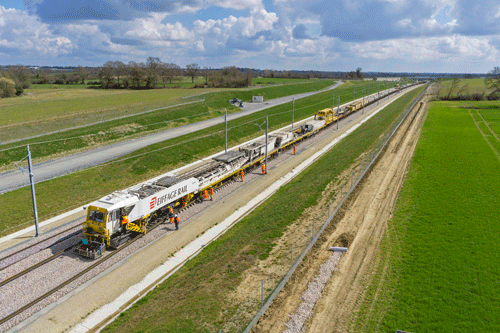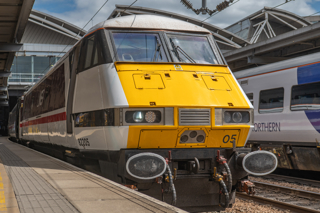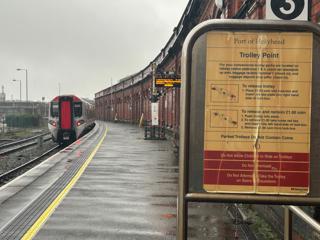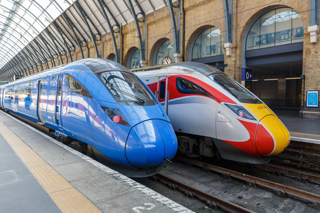Heavy lorries rolled along the black asphalt strip that curved gently up and over the nearest hill. Its smooth surface needed only a white line to be complete.
Yet there was no paint to come. Instead, those lorries dumped their loads of heavy stone chips into the hoppers of pavers that spread it precisely over that black asphalt. For this was no road but a new high-speed railway line from Le Mans to Rennes, in western France.
Construction company Eiffage contends that the asphalt will result in a stronger trackbed that’s better able to carry the dynamic loads of trains running at up to 200mph (320kph). It’s one of the innovations the firm has brought to high-speed rail (HSR) to meet the needs of ever increasing train speeds.
Britain’s HS2 project will involve higher speeds than ever before on UK rails - 250mph (400kph) - and such innovations will become more important. French railway company SNCF ran a train at 357mph (575kph) under test conditions in 2007 and the latest European high-speed trains are designed for 225mph (360kph). As train speeds increase, it’s clear that track and formation design must match that capability. It must cope with the transition from earthworks to harder structures, such as bridges and viaducts. Ballast must withstand higher dynamic loads without fluidisation, which can cause the track to shift from its proper position. (The vibrations imparted by ballast tampers deliberately fluidise ballast so that it packs properly around sleepers.)
Eiffage is building the Le Mans-Rennes line under a project abbreviated to BPL - Bretagne-Pays de la Loire - reflecting the areas in which those cities stand. It’s a €3 billion French public-private partnership project with funding coming from national and local government and SNCF, a €1bn loan from 12 banks to special purpose company Eiffage Rail Express (ERE) and €129 million euros from Eiffage Group itself.
The deal lasts for 25 years, and includes six years of construction followed by 19 years of maintenance. Eiffage fully owns construction company CLERE and operating company OPERE.
The line itself will feature 214km of track, 182km of which is 320kph line, plus 32km of junction links to the existing French network. There are no stations, but eight junctions add to the complexity.
It has been a long time coming. Back in 1984, when SNCF built its second HSL, from Paris to Le Mans, it included provision (including bridges at Connerre junction, east of Le Mans) for the line that Eiffage is now building. A decade later work had been completed on the scope of the project and another decade passed before a public inquiry took place. This led to a tender in 2008 for which Eiffage was declared the winner. It signed its public-private partnership (PPP) deal with French railway owner RFF in 2011. Trains will be running from 2017, giving a Paris-Rennes journey time of less than 1 hour 30 minutes - 37 minutes less than today’s journey times.
Eiffage’s design, build and maintain contract gives it great incentives to build a railway based on best whole-life costs using systems engineering, rather than just building the system for the lowest cost and leaving other firms to cope with spending more to maintain it. According to Project Director Michel Oléo, the project also benefitted from SNCF allowing some flexibility with existing French High Speed Line (HSL) specifications. This allowed for innovation, he stressed.
A flatter management structure has been created, which, argues Oléo, allows for further innovation. Decisions can now be made at the correct place, rather than always being made at the top. For civil work, the Le Mans-Rennes HSL is divided into seven parts, each overseen by a manager who is responsible for everything in his or her section. These sections are sized so that the manager can easily cover the patch in a day. For BPL, each section is around 30km long.
Designers, builders and maintainers work together and have done from day one. This way, says Oléo, the best decision can be made between, for example, the length of earthworks and the length of a bridge.
Of these integrated teams, he says: “They have to be in the same place with the same boss and understand what others are doing in a clear and simple language. We need to have people together every day, in the same building. We normally don’t do this intense sharing of problems, but it works.”
Project Technical Director Imed Ben Fredj expands on this, saying that the integrated design team must consider ease of construction, planning, safety and costs. Integration allows those building the line to make decisions early in the design phase. “If we want to be successful, the team must work towards one target - the project,” he says, while recognising that each part of the team still has to make a profit.
Oléo adds: “With system engineering, if you can achieve your result with fewer interfaces then it will be more reliable and more efficient.”
Eiffage certainly has some interfaces to deal with. For example, the BPL line will have three signalling systems; TVM signalling for high speed, as well as ERTMS at Levels 1 and 2. Level 2 is needed as a result of European standards for interoperable railways while TVM is standard equipment for France’s fleet of TGV trains. ERTMS Level 1 is needed for freight trains using the eastern part of the line as a diversion around Le Mans. How many freight locomotives will be equipped with the necessary on-board kit for ERTMS remains to be seen but the facility for freight to use BPL came at the request of local government in Le Mans, which was keen to remove freight trains from the city centre. There is also provision for a local service between Laval and Sablé-sur-Sarthe to run (there is currently no direct railway between the two towns).
The two are some of the more surprising aspects of local consultation which is just as important a part of French life as it is in Britain. Elsewhere, bridges have been painted in colours according to local preferences, including the 300m viaduct over the environmentally protected valley of the River Courbe. Land temporarily used for building purposes has been returned to farmers according to their needs in an area famed for its agriculture. In some cases, it means that what might have been a gentle cutting slope is now steeper to maximise the usable land above it.
Eiffage encouraged the use of local workers. At the height of construction, 2,000 staff were employed, of which 800 were local while 15% of the total man hours were fulfilled by those who had been unemployed before the project. The company placed high emphasis on skills and learning
France takes a similar view to Britain when it comes to protecting wildlife and the environment. The route runs through the habitats of Marbled Newts, Common Parsley Frogs, Bechstein’s Bats, Hermit Beetles and Natterjack Toads, along with plants such as Soft Hornwort. Otters too were considered in the design of culverts carrying watercourses under the trackbed, with culverts made large enough to accommodate them.
The BPL route features some impressive structures, including viaducts over rivers and bridges over railways and roads, including motorways. When design changes called for one river bridge to be moved 10m to one side, the line was adjusted for 14km east and west to compensate for the shift - ample demonstration that a high-speed line is more than just its component parts.
Eiffage developed a standard design for most of its bridges, allowing for component construction off-site and quicker assembly on-site. For the first time, it used cut-and-cover tunnels made from three-piece pre-cast concrete arches which halves the cost compared with casting concrete in situ (they have been used on French roads before but not railways). Further innovation came with other cut-and-cover tunnels (sometimes called green tunnels) built using steel sheet-pile walls rather than diaphragm walls.
The decision to use asphalt resulted from the problems Eiffage has seen on France’s eastern HSL (LGV Est). It also has some construction advantages, in that lorries can be driven on it (heavy steel plates are laid to provide turning areas so the lorries do not damage the trackbed) but it also saves on ballast, with a top layer of 32cm rather than 35cm.
On this layer runs a MATISA track-laying machine operated by Eiffage subsidiary Wittfeld to lay the two tracks. The machine has run at up to 2.2km per day, although 1.5km per day is more usual. It works to an alignment tolerance of 10mm left and right of the track’s design route with the machine laying sleepers, threading rails into position and then pushing into place the clips that secure the rails to the sleepers.
The machine carries a stock of monoblock sleepers to an SNCF design (Eiffage even considered building its own sleeper factory at one point) and a stock of rails. They are temporarily bolted together to form 900m lengths which are then dragged out in front of the machine. Once the rails are lying to the left and right, the machine slowly moves forward until it runs out of rails, at which point another long string is pulled forward. Their temporary fishplate joints will be removed, the rail containing the holes cut away and then two lengths joined using flash-butt welding
and appropriately stressed. The machine returns to base every night to be loaded
with more materials.
The stones which form the line’s ballast are noticeably larger than those used in Britain. This allows the ballast to cope with the forces of fast running. It’s also laid in a precise shape that has two distinct raised sections on either side of a lower central trough. This ensures that when the sleepers are laid they are correctly supported to spread the loads imposed through the rails. The trough prevents any sleepers being supported merely at their centre.
HSLs demand tight tolerances. At a recent Institution of Mechanical Engineers conference, HS2 Rail Systems Engineering Director Mark Howard talked about track geometry tolerances of 1mm. He also noted the importance of the user (passenger and maintainer) and the need to put people at the heart of HS2’s design. This is all reflected in the work Eiffage has under way in France.
Eiffage subsidiaries have completed power and cabling works with two major sub-stations along the route drawing electricity from the French national grid. The subsidiaries have also co-ordinated signalling installation by Ansaldo and overhead line equipment (OLE) erection by Colas Rail (OLE installation is one of the few rail disciplines that Eiffage does not encompass). This catenary is to SNCF’s V350 design. Masts are erected during trackbed construction before ballast, sleepers and rails, which, initially, looks like a road flanked by masts and blue and yellow signal marker boards. On some of the link lines to SNCF’s classic network, even the signals have been installed before the tracks!
Meanwhile, Eiffage’s maintenance base is collating the information it needs to keep the line in good condition. The site is already busy, not least because it doubles as a base for the track laying machine. It will be from here that maintenance is planned, stock levels monitored and efficiency analysed to further improve maintenance. Track staff will be based here (25 for signalling, electrification and telecoms and a production team of 15, including works train drivers and control centre staff).
Software will also be used - the Maximo system has been selected to monitor the state of the line. Eiffage believes that this, combined with ArcGis mapping, is sufficient. It uses BIM (building information management) and plans to use BIM on HS2, learning from its experience on BPL.
The track was also designed with maintenance in mind, and frequent wide spaces have been created alongside the tracks in which equipment can be placed. These spaces are the equivalent of a maintenance lay-by on a road, although the French call them ‘platforms’. The importance of including them is one of the lessons Eiffage learnt from its joint venture on the Perpignan-Figueras HSL between France and Spain (which also includes the 8km Perthus tunnel under the Pyrenees).
The company believes it can bring this maintenance experience to HS2 because, although it understands that HS2 plans to do its own maintenance, whole-life costs are improved if maintenance is considered during the design phase.
Watching a high-speed railway being built is an impressive sight and it’s abundantly clear that Eiffage has the necessary skills and experience. That’s why it is now looking towards HS2 and the opportunities that line presents. Indeed, the BPL line will open in 2017 - around the time construction work should start on HS2. That there could be a seamless transfer of skilled people has not escaped Eiffage’s notice.
It has joined Carillion and Kier in a joint venture to bid for HS2 construction contracts. The consortium has been completing pre-qualification questionnaires (PQQs) with bidding for real contracts expected to follow over the next year or so. As Michel Oléo says: “We have experience of high-speed lines. We have experience of being free to innovate and of working with different partners. I hope HS2 recognises this in our PQQ.”
The three partners bring different experience. Kier and Carillion have extensive UK experience. Kier delivered the civil engineering needed for High Speed 1 around King’s Cross, including eight bridges and viaducts, tunnels and earthworks. It had to cope with the operational railways around it - including Network Rail and London Underground’s Piccadilly Line - as well as the Grand Union Canal.
More recently, the company is closely involved with Crossrail, London’s major east-west rail building project. Kier has taken on contract C435 for Farringdon station, which will deliver two ticket halls at either end of two platform tunnels. The western hall will be shared with Farringdon’s Thameslink services while the eastern hall will provide access to Underground services at Barbican.
Two further Crossrail joint venture contracts highlight Kier’s expertise; C300 and C410 for the Western Running Tunnels and for all station tunnels and sprayed tunnel linings in Bond Street and Tottenham Court Road stations, plus access shaft contracts at Liverpool Street and Whitechapel stations.
Meanwhile, Carillion is Network Rail’s largest contractor as well as being one of the major players on the UK Highway programme. Its most significant current rail project involves carrying out major modifications to the GW mainline at Old Oak Common (a significant HS2 hub) and West London, for Crossrail.
Carillion is proud of its environmental and sustainability record on both rural and urban projects throughout the UK. This included the East London Line project, key to the success of the 2012 Games.
The trio - Carillion, Eiffage and Kier - announced their joint venture last June with their chief executives welcoming the chance to work together. Their combined expertise covers the disciplines needed by HS2, with its mix of long tunnels, open country construction, links to existing rail lines and the need to keep local communities content, not only during construction but also afterwards, when trains are running.
France is an acknowledged leader and pioneer of high-speed rail travel. Few countries can bring its depth of experience to bear in the field and even fewer European countries have this ability. Britain already benefits from French know-how with High Speed 1 running from London to the Channel Tunnel. It uses TVM signalling and track and OLE designs to French standards and performs with delays which are measured in just seconds.
A joint venture of Carillion, Eiffage and Kier is exceptionally well placed to combine French experience with British knowledge to build High Speed 2 and so radically transform the capacity and connectivity of Britain’s rail network.
- This feature was published in the HS2 supplement of RAIL 789 (December 9 2015)
















Login to comment
Comments
No comments have been made yet.